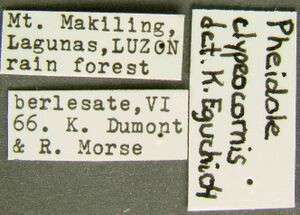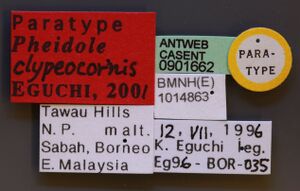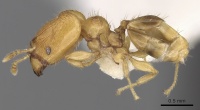Pheidole clypeocornis
| Pheidole clypeocornis | |
|---|---|

| |
| Scientific classification | |
| Kingdom: | Animalia |
| Phylum: | Arthropoda |
| Class: | Insecta |
| Order: | Hymenoptera |
| Family: | Formicidae |
| Subfamily: | Myrmicinae |
| Tribe: | Attini |
| Genus: | Pheidole |
| Species: | P. clypeocornis |
| Binomial name | |
| Pheidole clypeocornis Eguchi, 2001 | |
This species nests in rotting wood, and stores up a number of tiny seeds in its nest (Eg96-BOR-347, Eguchi 2001). Heterick & Kitching (2022) collected this species in leaf litter within a lowland dipterocarp forest in Brunei.
Identification
Eguchi (2001) - P. clypeocornis is closely related to Pheidole maculifrons (known only from the Philippines), Pheidole rugifera, Pheidole tenebricosa, Pheidole kikutai and Pheidole hortensis, and all these are recognised among the congeners by the combination of the characteristics noted under P. hortensis. Among the species known from Borneo the closest relative is P. hortensis, in which each lateral part of clypeus of the major never develops into a horn.
Keys including this Species
- Key to Pheidole majors and minors of Borneo
- Key to Pheidole majors of Borneo
- Key to Pheidole minors of Borneo
Distribution
Latitudinal Distribution Pattern
Latitudinal Range: 6.734778° to 4.199°.
| North Temperate |
North Subtropical |
Tropical | South Subtropical |
South Temperate |
- Source: AntMaps
Distribution based on Regional Taxon Lists
Indo-Australian Region: Borneo (type locality), Brunei Darussalam, Indonesia, Malaysia, Philippines, Singapore.
Oriental Region: Thailand.
Distribution based on AntMaps
Distribution based on AntWeb specimens
Check data from AntWeb
Countries Occupied
| Number of countries occupied by this species based on AntWiki Regional Taxon Lists. In general, fewer countries occupied indicates a narrower range, while more countries indicates a more widespread species. |

|
Estimated Abundance
| Relative abundance based on number of AntMaps records per species (this species within the purple bar). Fewer records (to the left) indicates a less abundant/encountered species while more records (to the right) indicates more abundant/encountered species. |

|
Biology
Castes
Worker
Minor
           
| |
| . | |
Major
       
| |
| . | |
Queen

| |
| . | |
Nomenclature
The following information is derived from Barry Bolton's Online Catalogue of the Ants of the World.
- clypeocornis. Pheidole clypeocornis Eguchi, 2001b: 44, fig. 11 (s.w.q.m.) BORNEO.
Unless otherwise noted the text for the remainder of this section is reported from the publication that includes the original description.
Description
Worker
Major (n=8): TL 1.8-2.3 mm, HL 0.78-0.93 mm, HW 0.69-0.80 mm, SL 0.34-0.38 mm, FL 0.41-0.48 mm, CI 86-92, SI 47-51, FI 59-63. Head broadest at about 3/5 distance of head (as measured from the mid-point of a transverse line spanning the anteriormost and posteriormost projecting points, respectively (cf. Fig. 2A)), in profile weakly impressed on vertex (Fig. 11). Hypostoma bearing one distinct median process (rarely it is rather reduced). Clypeus without a median longitudinal carina, with anterior margin very weakly concave medially; lateral part of clypeus developed into a horn (Fig. 11). Eye situated at about 1/3 distance of head; distance between mandibular insertion and anterior margin of eye 1.4-1.6 times as long as maximal diameter of eye. Frontal carina horizontal, extending backward to about 2/3 distance of head. Antennal scrobe narrowly overhung by frontal carina. Antenna with 3-segmented club; scape extending backward to 5/9-3/5 distance of head; terminal segment 1.3-1.4 times as long as preceding two segments together. Masticatory margin of mandible with apical and preapical teeth, and two denticles in front of basal angle. Promesonotum forming a high dome, without a distinct prominence on its posterior declivity; each dorsolateral portion of the dome well and roundly produced outward. Mesopleuron divided by a weak transverse impression into upper and lower parts. Propodeal spine triangular or elongate-triangular, ca. 1.5 times as long as diameter of propodeal spiracle. Petiole 1.5-1.7 times as long as postpetiole (excluding helcium); petiolar node in posterior view not emarginate at apex. Postpetiole 1.4-1.8 times as broad as petiolar node.
Frons longitudinally rugose, with smooth and shining interspaces; dorsal and dorsolateral faces of occipital lobe reticulate with enclosures smooth and shining, or rarely punctured very weakly; outer face of mandible weakly rugose only laterally near its base; dorsum of promesonotal dome smooth and shining with several transverse rugulae; lateral face of the dome and lower part of mesopleuron smooth and shining; upper part of mesopleuron weakly punctured; propodeum smooth and shining over the surface, or weakly punctured partly on lateral face; ventral faces of midcoxa and hindcoxa distinctly reticulate; lateral face of petiole very weakly punctured; dorsum of petiole, and postpetiole and gaster smooth and shining. Outer face of mandible covered with very short appressed hairs (< or = 0.02 mm in length), which are much shorter than distance between piligerous punctures; submarginal zone of masticatory margin of mandible with a row of longer appressed to decumbent hairs. Body yellowish-brown, sometimes with darker mandible, clypeus and gaster; legs a little lighter than alitrunk.
Minor (n=8): TL 1.3 mm; HL 0.40-0.43 mm, HW 0.38-0.40 mm, SL 0.33-0.35 mm, AL 0.50-0.54 mm, FL 0.34-0.38 mm, CI 92-96, SI 85-91, FI 88-96. It is at present impossible to separate the minor of this species from that of P. hortensis in external morphology.
Type Material
Holotype Major, colony: Eg96-BOR-035, Tawau Hills Park, Sabah, E. Malaysia (Borneo), K. Eguchi leg., 1996, deposited in Universiti Malaysia Sabah. Paratypes 18 majors, 22 minors, 1 teneral queen and 2 males from the same colony to which the holotype belongs, deposited in The Natural History Museum, Museum Brunei, Museo Civico di Storia Naturale, Genoa, Museum of Comparative Zoology, Musee d'Histoire Naturelle Genève, Museo Civico di Storia Naturale, Milano, Naturhistorisches Museum Wien, Vienna and UMS.
References
- Eguchi, K. 2001a. A revision of the Bornean species of the ant genus Pheidole (Insecta: Hymenoptera: Formicidae: Myrmicinae). Tropics Monograph Series. 2:1-154.
- Eguchi, K. 2003. A Study on the Male Genitalia of Some Asian Species of Pheidole (Hymenoptera, Formicidae, Myrmicinae). Sociobiology 41(2): 317-355 (page 323, figs. 5A, B male genitalia described)
- Heterick, B.E., Kitching, R.L. 2022. The ants (Hymenoptera: Formicidae) of a one-hectare plot of lowland dipterocarp forest. Entomologist’s Monthly Magazine 158(4), 261–272 (doi:10.31184/m00138908.1584.4153).
- Khachonpisitsak, S., Yamane, S., Sriwichai, P., Jaitrong, W. 2020. An updated checklist of the ants of Thailand (Hymenoptera, Formicidae). ZooKeys 998, 1–182 (doi:10.3897/zookeys.998.54902).
- Wang, W.Y., Soh, E.J.Y., Yong, G.W.J., Wong, M.K.L., Benoit Guénard, Economo, E.P., Yamane, S. 2022. Remarkable diversity in a little red dot: a comprehensive checklist of known ant species in Singapore (Hymenoptera: Formicidae) with notes on ecology and taxonomy. Asian Myrmecology 15: e015006 (doi:10.20362/am.015006).
References based on Global Ant Biodiversity Informatics
- Berghoff S.M., U. Maschwitz, and K.E. Linsemair. 2003. Hypogaeic and epigaeic ant diversity on Borneo: evaluation of baited sieve buckets as a study method. Tropical Zoology 16: 153-163.
- Bruhl C.A. 2001. Leaf litter ant communities in tropical lowland rain forests in Sabah, Malaysia: effects of forest disturbance and fragmentation. PHD thesis Wurzburg Universitat, 168 pp.
- Davidson D. W., S. C. Cook, R. R. Snelling and T. H. Chua. 2003. Explaining the Abundance of Ants in Lowland Tropical Rainforest Canopies. Science 300: 969-972.
- Eguchi K. 2001. A revision of the Bornean species of the ant genus Pheidole (Insecta: Hymenoptera: Formicidae: Myrmicinae). Tropics Monograph Series 2: 1-154.
- Eguchi K. 2003. A study on the male genitalia of some Asian species of Pheidole (Hymenoptera, Formicidae, Myrmicinae). Sociobiology 41: 317-355.
- Eguchi K., and S. Yamane. 2003. Species diversity of ants (Hymenoptera, Formicidae) in a lowland rainforest, northwestern Borneo. New Entomol. 52(1,2): 49-59.
- Jaitrong W., and T. Ting-Nga. 2005. Ant fauna of Peninsular Botanical Garden (Khao Chong), Trang Province, Southern Thailand (Hymenoptera: Formicidae). The Thailand Natural History Museum Journal 1(2): 137-147.
- Jaitrong W.; Nabhitabhata, J. 2005. A list of known ant species of Thailand. The Thailand Natural History Museum Journal 1(1): 9-54.
- Pfeiffer M.; Mezger, D.; Hosoishi, S.; Bakhtiar, E. Y.; Kohout, R. J. 2011. The Formicidae of Borneo (Insecta: Hymenoptera): a preliminary species list. Asian Myrmecology 4:9-58



